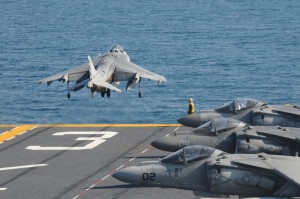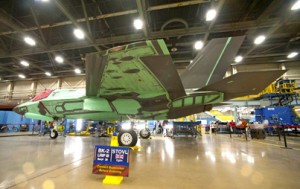3/19/12 by Robbin Laird
As Ed Timperlake has argued in a companion piece, the UK shifting from the F-35C to an F-35B/A mix would make inherently good sense.
At the heart of the shift is the ability to gain significant flexibility with the use of the new UK carriers and to integrate the assets flying off of those carriers with the Royal Air Force and/or allied Air Forces flying land based or sea-based air.
At the heart of the inherent flexibility is the emergence of a new approach to the Expeditionary Strike Group or ESG presaged in Bold Alligator 2012. In the exercise, the migration from the ARG-MEU already underway under the influence of the Osprey to a much larger strike formation operating from a distributed seabase was evident. The Osprey was at the heart of the tactical mobility, which has strategic consequences for how a distributed seabase can operate.
And the B operating off of the large deck amphibs will add what we have called the honeycombed air system providing air cover and close combat support to the insertion and strike force.
As General “Dog” Davis, 2nd Marine Air Wing, commented in a recent interview:
The F-35 community of users – sea based and land based — will be able to create a pretty tight air grid over the top of the distributed battle space so we can share information very freely out there.
To me, the key is to have these airplanes networked overtop, where they’re able to see deep into the enemy battle space, or the objective area, but also sharing that information. I want not just the airplanes to share their information, but the ships as well to be able basically pass that information back and forth freely.
The large deck amphibious ship is more analogous to the Queen Elizabeth class carriers than either the Nimitz or the Gerald Ford. And what the large deck amphibs with 22 F-35Bs aboard (if so desired) can do is to tie together an Expeditionary Strike group and tie in other air assets, whether land-based or large deck carrier based.
The deck space on the amphibs or the Queen Elizabeth class carriers can be configured to the mission and evolve what is appropriate to the tasks. The cats and traps built into a Queen Elizabeth will limit the ability to have the flexibility of deck spotting which a V/TOL aircraft can provide.
(On efficiency in using deck space see https://sldinfo.com/augmenting-the-seabase/).

The Brits are not likely in any case to follow the con-ops of the Carrier Battle Group; they will be evolving the con-ops of the ESG. Whether with their own ships and air assets, or those of allies – American or not – the Queen Elizabeth with F-35Bs on board can operate as an ESG focal point. And because of the deck flexibility, they will be able to mix and match helos with airplanes, unmanned and manned or whatever evolves over the next 40 years of the life of the ship.
The RAF buying F-35As makes inherently good sense because it will be the cheapest of the F-35s and be produced in large numbers over the course of the program. And the shared combat systems means that the F-35Bs operating off of the carrier can work inseparably with the RAF or ANY other land-based F-35s which the Brits will need to work with.
The implications for the UK’s coalition approach are significant. The inherent flexibility of the F-35B enabled deck means that the British can lead an operation, can contribute to an operation, or support an operation. A distributed sea base is made up of a variety of platforms, ranging from patrol boats, frigates, destroyers, submarines, etc. The F-35B can put a cover over the distributed seabase, providing air cover, seamless transition from air-to-air to close combat support, and can connect through MADL with whatever F-35 assets are available from the RAF or allies. Remembering that allies in Europe and the Middle East are buying F-35As in decent numbers, this means a significant expansion of what the F-35Bs aboard the carrier CAN DO. No platform fights alone in the F-35 world.
It also means that the Royal Navy can operate Special Forces off of the Queen Elizabeth along with the Bs. Deck spotting and deck management are an important part of mission management and mission success. This means as well, that coalition assets can land on the carrier and leverage the sea-base while the F-35B is flying its C4ISR D mission sets.
There is also a special relationship, which can be developed with the Italians, and their new F-35B enabled carrier. In discussions with Italians, it is clear that their carrier not only is built for F-35Bs as the enabler but that the way ahead is a mix of Bs and As. And the Italians are starting down the road thinking of some innovative approaches to combing them into an integrated strike force for operations throughout their areas of interest.

And it is clear that the role of the sea base in the evolution of Mediterranean and Middle East operations is only going to go up. But this is not a sea base isolated from the operations of land-based air. As the ESG exercise demonstrated off of the Shores of Virginia and North Carolina, 16 Harriers can work very nicely with other air assets whether coming from the large deck carriers or from land bases.
This model can be followed with Arab Air Forces, the Israeli Air Force or Western Air Forces deployed temporarily on Arab soil. The point is that the organizer of the spear is on the sea-base, and this capability can be conjoined with the various air combat centers extant or being developed in the region.
https://sldinfo.com/bold-alligator-2012-and-the-middle-east/
In short, the new British carriers are an important contributor in shaping the future of maneuver warfare from the sea. And as the F-35s are engaged, the forward deployed sensors can guide a newly enabled surface and sub-surface fleet with a new generation of weapons – loitering, penetrating and lethal – to provide the “arsenal” ship support to the air and ground forces maneuvering to provide for situational dominance.
And with the new approach, the mix and match approach to basing – land, sea and allied – allows for a very flexible capability to provide for strategic and tactical dominance.
(For a discussion of the new maneuver concept see
https://sldinfo.com/re-thinking-maneuver-warfare-from-the-sea/).

